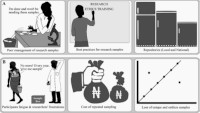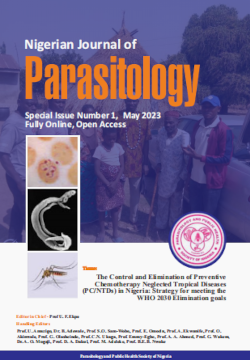Parasite repository - The future of Parasitological Research in Nigeria
https://dx.doi.org/10.4314/njpar.v43i2.21
Keywords:
PPSN, Nigeria, Institution, Genomics, Repository, ParasiteAbstract
Biorepositories are an important resource for today’s research. To obtain more scientific information, stored samples from older repositories are being investigated using modern techniques and technologies, while new repositories are being built to facilitate genomic studies. Parasitological research has progressed from basic laboratory procedures to using molecular and genomic methodologies to understand parasite biology, necessitating the creation of parasitology-based biorepositories. Parasite biorepositories can reduce the cost of frequent sampling in resource-constrained situations and enhance best research practices, in addition to enhancing research productivity. Repositories can also help to prevent the loss of biological materials from uncommon, endangered, or newly found species. In Nigeria, the available repositories are mostly for the archiving of clinical samples. To promote parasite genomics research in Nigeria, a parasite library is required. Through membership, institutional, and international support, national groups such as the Parasitology and Public Health Society of Nigeria (PPSN) can build and maintain parasite biorepositories.
References
Siwek, M. (2015). An Overview of Biorepositories-Past, Present, and Future. Military Medicine 180 (10): 57–66.
Hewitt, R. E. (2011). Biobanking: the foundation of personalized medicine. Current Opinion in Oncology 23(1): 112–119.
Staunton, C. and Moodley, K. (2013). Challenges in biobank governance in SubSaharan Africa. BMC Medical Ethics 14, 35. doi.org/10.1186/1472-6939-14-35
Institute of Human Virology (IHVN) (2022). Institute of Human Virology Nigeria. 2022).
Adepoju, P. (2019). Africa's first biobank start-up receives seed funding. Lancet 394 (10193), 108. doi.org/10.1016/S0140-
(19)31614-9
Casson, P. R., Krawetz, S. A., Diamond, M. P., Zhang, H., Legro, R. S., Schlaff, W. D., Coutifaris, C., Brzyski, R. G., Christman, G. M., Santoro, N., Eisenberg, E., and Reproductive Medicine Network(2011). Proactively establishing a biologic specimens repository for large clinical trials:
an idea whose time has come. Systems Biology in Reproductive Medicine 57(5): 217 – 221. doi.org/10.3109/19396368.2011.604818
Vaught, J. B., and Henderson, M. K. (2011). Biological sample collection, processing, storage and information management. IARC scientific publications, (163): 23–42.
Annaratone, L., De Palma, G., Bonizzi, G., Sapino, A., Botti, G., Berrino, E., Mannelli, C., Arcella, P., Di Martino, S., Steffan, A., Daidone, M. G., Canzonieri, V., Parodi, B., Paradiso, A. V., Barberis, M., Marchiò, C., and Alleanza Contro il Cancro (ACC) Pathology and Biobanking
Working Group. (2021). Basic principles of biobanking: from biological samples to precision medicine for patients. Virchows Archiv: an International Journal of P`athology 479(2):233 – 246. doi.org/10.1007/s00428-021-03151-0
Abimiku, A. G., Croxton, T., Ozumba, P. J., Agala, N., Balogun, O., Jonathan, E., Onyemata, E., Ndifon, K., Nadoma, S., Anazodo, T., Peters, S. and Beiswanger, C. M. (2019). Blueprint for building a biorepository in a resource-limited setting that follows international best practices.
African Journal of Laboratory Medicine 8 ( 1 ) 7 2 2 . https://doi.org/10.4102/ajlm.v8i1.722.
Galbreath, K. E., Hoberg, E. P., Cook, J. A., Armién, B., Bell, K. C., Campbell, M. L., Dunnum, J. L., Dursahinhan, A. T., Eckerlin, R. P., Gardner, S. L., Greiman, S. E., Henttonen, H., Jiménez, F. A., Koehler, A., Nyamsuren, B., Tkach, V. V., Torres-Pérez, F., Tsvetkova, A. and Hope, A. G. (2019). Building an integratedinfrastructure for exploring biodiversity: field collections and archives of mammals and parasites. Journal of Mammalogy 100( 2 ) : 3 8 2 – 3 9 3 .https://doi.org/10.1093/jmammal/gyz048.

Published
How to Cite
Issue
Section
License
Copyright (c) 2023 Nigerian Journal of Parasitology

This work is licensed under a Creative Commons Attribution-NonCommercial-NoDerivatives 4.0 International License.




